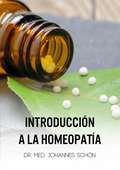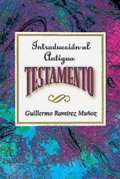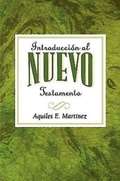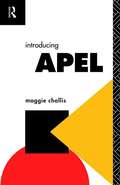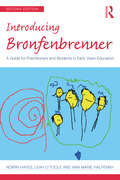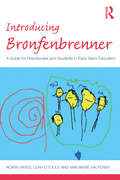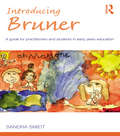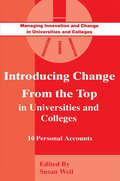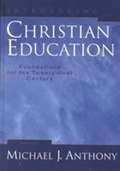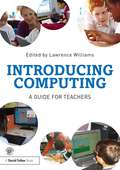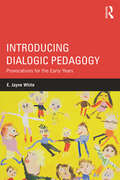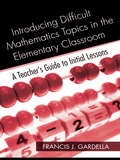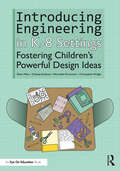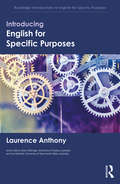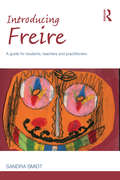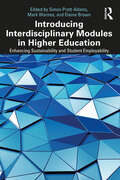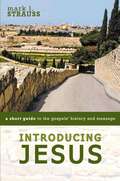- Table View
- List View
Intra-european Student Mobility In International Higher Education Circuits
by Christof Van MolAdopting an interdisciplinary approach, this book empirically investigates the (im)mobility decisions, social network formation, sense of European identity and migratory aspirations of higher education students. It draws on a large-scale survey, in-depth interviews and focus groups, conducted in Austria, Belgium, Italy, Norway, Poland and the UK.
Intro Geology Lab Manual 2024 (custom)
by TerryThis textbook is a comprehensive lab manual for the core curriculum Introductory Geosciences classes with both informational content and laboratory exercises. Topics include basic laws and theories in Geology, the Earth's interior and plate tectonics, water and climate change, igneous rocks and volcanoes, and earthquakes.
Intro to Business
by Robert A. RistauThe 21ST CENTURY BUSINESS SERIES is an innovative instructional program providing instructors with the greatest flexibility to deliver business content using a modular format. Instructors can create their own business courses by combining several Learner Guides in the Series to form one-semester or two-semester courses. The individual Learner Guides can also be used as enhancements to more traditional business courses or to tailor new courses to meet emerging needs. The design and content of each Learner Guide in the 21ST CENTURY BUSINESS SERIES is engaging yet easy for students to use. The content focuses on providing opportunities for applying 21st skills while enabling innovative learning methods that integrate the use of supportive technology and creative problem solving approaches in today's business world. The Introduction to Business Learner Guide covers today's most relevant business topics such as how business has been affected by the global economic crisis and recovery as well as global environmental issues. The roles of marketing and human resources management are also incorporated into this Learner Guide.
Introducción a la homeopatía
by Dr Johannes Schön¿Cómo funciona la homeopatía y cómo podemos utilizar los principios de la homeopatía en la práctica? En este libro encontrará una introducción fácilmente entendible a la fascinante forma de actuar de la homeopatía.
Introducción al Antiguo Testamento AETH: Introduction to the Old Testament Spanish AETH
by Association for Hispanic Theological EducationEl Estudiante avanzado del Antiguo Testamento podrá encontrar en esta introducción un análisis sobrio del estado actual de la disciplina, y los pastores y pastoras, al igual que los maestros y maestras de escuela bíblica—descubrirán en sus paginas buenas ideas para elaborar estudios que ayuden a las congregaciones a entender y disfrutar la importante literatura bíblica veterostestamentaria.
Introducción al Nuevo Testamento AETH: Introduction to the New Testament Spanish
by Aquiles E. MartinezEl Estudiante avanzado del Nuevo Testamento podrá encontrar en esta introducción un análisis sobrio del estado actual de la disciplina, y los pastores y pastoras, al igual que los maestros y maestras de escuela bíblica—descubrirán en sus paginas buenas ideas para elaborar estudios que ayuden a las congregaciones a entender y disfrutar la importante literatura bíblica veterostestamentaria.Written in Spanish, this work highlights the importance of understanding the New Testament, broadly defining it in a simple, yet organized, concrete manner. Martinez investigates the contents, purpose and context of each book of the New Testament, explaining how they became part of the canon and exploring the realities of geography, history, politics, economics, culture, philosophy, and religion in biblical times. The book includes other helpful suggestions for examining the New Testament and is ideal for classroom or personal study.
Introducing APEL (Further Education: The Assessment and Accreditation of Prior Learning)
by Maggie ChallisThe fact that learning accumulates and exists outside an education or training environment cannot be disputed. Yet traditionally, it is only institutional, certificated learning that carries any status. Accreditation of Prior Experiential Learning systems seek to give positive credit for all learning, by placing it within a recognised accreditation framework. In the light of recent legislation, APEL systems offer the key towards more flexible and open delivery systems for futher education. Maggie Challis offers a detailed, practical introduction to the skills and processes of implementing an APEL system, exploring the seven key stages through which learners progress: * initial counselling * recognising and identifying skills * relating these skills to an agreed set of outcomes * gathering evidence of these skills * documentation of the evidence * assessment of the evidence * accreditation Detailed guidance is provided on setting up and monitoring services and tutors and managers alike will find advice on identifying appropriate learning programmes for students; access to higher education; redundancy counselling; and the transfer of professional qualifications gained overseas. Most importantly, Maggie Challis shows the potential for APEL across a wide range of learning contexts, in all areas of education and training.
Introducing Autism: Theory and Evidence-Based Practices for Teaching Individuals with ASD (Evidence-Based Instruction in Special Education)
by Ruth ErenWritten by educators for educators, Introducing Autism: Theory and Evidence-Based Practices for Teaching Individuals With ASD is an introductory text offering a broad picture of Autism Spectrum Disorder for students, teachers, related service providers, and other school personnel who are engaged in the education of individuals with ASD.Introducing Autism imparts knowledge and understanding of the broad spectrum of ASD and suggests evidence-based practices to support this population. Editor Dr. Ruth Eren and the text contributors provide readers with a firm foundation of facts, strategies, and processes that help explain and address the complex profile of an individual with ASD. As a result of this understanding, current and future practitioners will be equipped with the skills and strategies to work collaboratively and effectively with their school team as they create a program for a student on the spectrum.What’s included in Introducing Autism: Content supported by case studies based in authentic educational settings Evidence-based practices suggested for use in the classroom Voices from the Spectrum sections in each chapter which feature the viewpoints from individuals on the spectrum Introducing Autism: Theory and Evidence-Based Practices for Teaching Individuals With ASD will enable universities to offer a comprehensive course that provides a strong foundation of knowledge and understanding of ASD to prepare teachers and related service providers for certification.
Introducing Bronfenbrenner: A Guide for Practitioners and Students in Early Years Education (Introducing Early Years Thinkers)
by Nóirín Hayes Ann Marie Halpenny Leah O'TooleThe influence of Urie Bronfenbrenner’s model of development has been extensive in different areas of developmental science and education, and it continues to inform contemporary research and practice in many fields, including early childhood education. This book presents a comprehensive introduction to Bronfenbrenner’s model of development in reference to early childhood education. It draws on practice-based research to identify and animate key elements of the model impacting on early educational pedagogy and practice. This new and revised second edition identifies and explores the key elements of Bronfenbrenner’s model by referring to contemporary understandings of how children learn. It also includes a new chapter which considers repositioning early childhood education settings as interactive, relational spaces and provides a broader focus on the concept of transitional experiences in children’s daily lives. Along with new content on leadership and associated roles and practices in early childhood education, this book illustrates how Bronfenbrenner’s model can help bring quality to early learning environments and show how it can be incorporated into daily work with young children through vignettes, case studies and examples of good practice. Introducing Bronfenbrenner serves as an ideal read for professionals around the world working with children in early childhood settings, and students training to become early childhood professionals at degree level on undergraduate programmes, as part of vocational training or as part of continuous professional development.
Introducing Bronfenbrenner: A Guide for Practitioners and Students in Early Years Education (Introducing Early Years Thinkers)
by Nóirín Hayes Ann Marie Halpenny Leah O'TooleChildren learn in contexts, and the spaces, places and people they come into contact with have a deep influence on their development. Urie Bronfenbrenner’s bioecological model of development places the child at the centre of this complex network, and his influence has been extensive in early childhood education. This book presents an introduction to Bronfenbrenner’s model of development, drawing on practice-based research to identify and animate key elements of his model’s impact. It illustrates how his model can help bring quality to early learning environments and incorporates it into daily work with young children. As well as providing a glossary of key terms, Introducing Bronfenbrenner covers areas such as: a bioecological perspective on educational transition; early education as a dynamic process; nurturing children’s learning and development; reflecting the bioecological in early years practice. Using a variety of vignettes, practical examples of good practice and case studies, Introducing Bronfenbrenner is an essential guide to his work. It will be of interest to professionals working with children in early childhood settings and to undergraduate students training to become early childhood professionals.
Introducing Bruner: A Guide for Practitioners and Students in Early Years Education (Introducing Early Years Thinkers)
by Sandra SmidtSandra Smidt takes the reader on a journey through the key concepts of Jerome Bruner, a significant figure in the field of early education whose work has spanned almost a century. His wide-ranging and innovative principles of early learning and teaching are unpicked here using everyday language and the links between his ideas and those of other key thinkers of the twentieth and twenty-first centuries are revealed. Introducing Bruner is the companion volume to Introducing Vygotsky and is an invaluable work for anyone involved with children in the early years. The introduction of Bruner's key concepts is followed by discussion of the implications of these for teaching and learning. This accessible text is illustrated throughout with examples drawn from real-life early years settings and the concepts discussed include: how children acquire language how children come to make sense of their world through narrative the significance of play to learning the importance of culture and context the role of memory what should children be taught: the spiral curriculum how should children be taught: scaffolding and interaction. The book also looks, crucially, at what those working or involved with young children can learn from Bruner, and includes a helpful glossary of terminology. This fascinating insight in to the life and work of a key figure in early years education is essential reading for anyone concerned with the learning and development of young children.
Introducing Change from the Top in Universities and Colleges: Ten Personal Accounts (Managing Innovation And Change In Universities And Colleges Ser.)
by Susan WeilPart of a series reflecting the recent changes in further and higher education, this volume relates the true stories of 10 educational managers and their experiences of recent events. The managers tell how they have maintained direction and impact, balanced pressures and set up their own systems.
Introducing Christian Education: Foundations of the 21st Century
by Michael J. AnthonyMichael Anthony offers Introducing Christian Education to fill the need in the C.E. curriculum for an introductory foundations textbook--one that provides an overview and understanding of the broad range of subjects included in C.E.--for college and seminary use.
Introducing Computing: A guide for teachers
by Lawrence WilliamsThis timely new text provides an accessible introduction to teaching Computing, and computer programming. Specifically designed for non-specialists who need to develop new skills in Computing in order to meet the new curriculum requirements, it offers a useful guide to the subject, alongside worked examples of good practice. Packed full of practical advice, the book examines different approaches to introducing children from age 5 to Computing, and describes a wide range of tried and tested projects that have been proven to work in schools. Including case studies and a glossary of key terms, it covers: The key concepts in Computing and computational thinking Using personal learning networks, social media and the 'wiki curriculum' to develop higher thinking skills and desirable learner characteristics Links to the curriculum at Key Stages 1, 2 and 3 Practical ways to develop children’s Computing skills alongside creative writing, art and music Gaming and computer science Featuring a companion website www.literacyfromscratch.org.uk with extensive support materials, examples of pupils’ work, links to software and downloadable lesson plans, this is an essential text for all teachers and trainees who are responsible for the new Computing curriculum.
Introducing Dialogic Pedagogy: Provocations for the Early Years
by E. Jayne WhiteIntroducing Dialogic Pedagogy presents some of the ideas of Russian philosopher Mikhail Bakhtin concerning dialogism in a way that will engage and inspire those studying early childhood education. By translating the growing body of dialogic scholarship into a practical application of teaching and learning with very young children, this book provides readers with alternative ways of examining, engaging and reflecting on practice in the early years to provoke new ways of understanding and enacting pedagogy. This text combines important theoretical ideas with a practical application to support practitioners who are keen to promote creativity and agency through ethical self-other relations. It provides unique insights into the amazing world of the youngest child, and offers enriched understandings of the profound impact of adults in their journey of becoming (or bildung). Key points covered include: Investigating dialogic philosophy and its application to early childhood education, with an emphasis on notions of justice, democracy, ethics and answerability Considering the relationship between dialogism and pedagogical approaches Theorising a range of approaches to relevant early childhood practice, as pedagogy This accessible and readable guide offers sound theoretical principles with practical suggestions for early years’ settings. The book is supplemented by an extensive online video resource website that will bring these revolutionary ideas to life. .
Introducing Difficult Mathematics Topics in the Elementary Classroom: A Teacher’s Guide to Initial Lessons
by Francis J. GardellaThis exciting text for the pre-service elementary teacher provides hands on mathematics lessons they can use to introduce mathematical concepts and skills that students find particularly challenging. Each chapter is divided into four sections: The Activity employs an engaging thought experiment to help the reader "visit a classroom" to understand how the lesson used to introduce the concept or skill would materialize in the class. The Mathematics provides the necessary mathematical background used in the lesson to make the actual teaching/learning situation comfortable for both the teachers and the learner. The Plan provides the reader with an actual lesson plan to engage the Activity in the classroom setting. Putting It All Together pulls the previous sections together with a summary of the chapter as well as further information for making the lesson successful. By providing models of what excellent lessons on a given topic look like, knowledge of the mathematics involved, and a concrete lesson plan structure this much-needed resource is the definitive mathematics planning vehicle that every teacher will want before they set foot in their own elementary classroom.
Introducing Emotional Freedom Techniques
by Moran ChristineThis title offers simple and effective techniques for emotional health and wellbeing. Emotional Freedom Techniques (EFT) is an energy therapy that is rapidly gaining recognition as a simple, yet very effective way to aid emotional and physical wellbeing. The techniques empower individuals to make their own changes in their thinking and feeling, by combining focus on an issue whilst tapping on the body's energy system. EFT provides highly flexible, easy-to-use and practical solutions for a huge range of emotional issues across all age groups. This book is a comprehensive information resource and 'how to' guide for health professionals and adults to introduce EFT into their day-to-day lives. It provides an extensive exploration of how EFT can be successfully applied to a wide range of social, emotional, behavioural and health issues. It includes case examples of phobias, fears, issues around behaviour, confidence, health issues, speech problems, depression, stress, anger, addictions, abuse, performance issues and managing pain. It offers an overview of some of the latest perspectives within neuroscience and physiology which reflect the changes that occur naturally when using EFT.
Introducing Engineering in K-8 Settings: Fostering Children's Powerful Design Ideas
by Christopher Wright Elissa Milto Chelsea Andrews Merredith PortsmoreIntroducing Engineering to K-8 Students will provide you with the tools you need to incorporate engineering design into your classroom. Rather than prescribing a specific curriculum to follow, this book will help you engage your students with hands-on, open-ended engineering design problems that can be easily integrated into your existing classroom setup.Beginning with the basics of K-8 engineering, and advancing to topics such as integrating engineering with other disciplines, documentation, and assessments, the chapters provide a how-to on creating open-ended engineering activities, design tasks, and projects that are reflective of the academic, social, emotional, developmental, and community goals of your students. An additional focus is on ways to adapt these pedagogical approaches to meet the needs of all students, representative of racially, ethnically, socioeconomically, and gender diverse populations and students who receive special education services. Case studies and practical implementation strategies are presented alongside more than fifteen lesson plans, with tips on how to modify the tasks presented in the book to work with your classroom and students. This user-centered approach will also help you create your own engineering lessons that meet your individual classroom objectives and interests, and be able to recognize and classify your students’ engineering behaviors to support them in enacting their ideas.No matter your experience or comfort level, this book will be an invaluable resource for elementary and middle school science and technology teachers at all career stages who are looking to introduce engineering design to their students.Additional classroom resources can be found online at introducingengineering.org.
Introducing English Studies
by Tonya Krouse and Tamara F. O’CallaghanFrom literary studies to digital humanities, Introducing English Studies is a complete introduction to the many fields and sub-disciplines of English studies for majors starting out in the subject for the first time. <P> The book covers topics including: <BR> history of English language and linguistics <BR> literature and literary criticism <BR> cinema and new media Studies <BR> composition and rhetoric <BR> creative and professional writing <BR> critical theory <BR> digital humanities <P> The book is organized around the central questions of the field and includes case studies demonstrating how assignments might be approached, as well as annotated guides to further reading to support more in-depth study. A glossary of key critical terms helps readers locate essential definitions quickly when studying and writing and revising essays
Introducing English as an Additional Language to Young Children: A Practical Handbook
by Kay Crosse`A definite must-have for all teachers of English confronted with early multilingualism′ - Times Educational Supplement The activities and guidance in this book will help teachers to develop the confidence and meet the individual needs of young children with English as an additional language across different settings. There are also practical and varied language teaching strategies to promote learning for children working individually or in small groups. The first part of the book focuses on the introduction and development of oral language skills and the particular needs of young "additional English language learners" settling into a new environment. It provides an introduction to the Foundation Stage curriculum and the ways in which links can be made with English as an additional language activity. The second part of the book presents practical activities grouped under the six areas of learning forming the early years curriculum. Each activity includes an appropriate objective, materials and preparation, key vocabulary to focus on and extension suggestions, as well as full guidance on how to manage the activity effectively. The book will be a valuable resource for all teachers, teaching assistants and other early years staff in day nurseries, nursery schools and other early years settings. Kay Crosse is a freelance early years consultant and was formerly head of Norland College.
Introducing English for Specific Purposes (Routledge Introductions to English for Specific Purposes)
by Laurence AnthonyIntroducing English for Specific Purposes presents the key concepts and practices of ESP in a modern, balanced, and comprehensive way. This book defines ESP and shows how the approach plays a crucial role in the world of English language teaching. Explaining how needs analysis, language and learning objectives, materials and methods, and evaluation combine to form the four main pillars of ESP, the book includes: practical examples that illustrate how the core theories and practices of ESP can be applied in real-world academic and occupational settings; discussion of some of the most hotly debated issues in ESP; insights on how ESP courses can be organized and integrated to form a complete program; reflection boxes, practical tasks, extension research questions, and resources for further reading in each chapter. Introducing English for Specific Purposes serves as an ideal textbook for graduate and advanced undergraduate students studying courses on English for Specific Purposes or English for Academic Purposes, as part of degrees in English for Specific Purposes, Education, ELT, Applied Linguistics, TESOL or TEFL. This comprehensive publication is also an invaluable reference resource for pre-service and in-service teachers of ESP, and for English program managers and administrators.
Introducing Freire: A guide for students, teachers and practitioners (Introducing Early Years Thinkers)
by Sandra SmidtThe famous Brazilian educator Paulo Freire has influenced educators, teachers and students in a broad tapestry of contexts and countries, as he challenged conventional thinking on how teachers ought to teach and learners ought to learn. By making his ideas accessible and relevant, this insightful and thought-provoking text draws out the relevance and topicality of Freire’s work and applies this to a wide range of educational settings, from adult education, through schools, to early years settings. Themes covered include: the lasting impact of illiteracy; the benefits and potential in becoming literate; literacy, language and power; the differences between banking and dialogic education; the social and political nature of learning. what kind of teaching and learning do we want? Using a variety of practical examples and case studies, Introducing Freire is an essential guide to the work of one of the most significant figures in education in the last century. Fascinating and accessible, this book is for anyone interested in teaching and learning, poverty and affluence, power and powerlessness, and society and change.
Introducing Genre and English for Specific Purposes (Routledge Introductions to English for Specific Purposes)
by Sunny HyonGenre analysis has become a key approach within the field of English for Specific Purposes and helps students understand particular language use patterns in target contexts. Introducing Genre and English for Specific Purposes provides an overview of how genre has been conceptualized and applied in ESP, as well as the features that distinguish ESP genre research and teaching from those of other genre schools. The macro and micro aspects of ESP genre-based pedagogy are also analysed and include: different possibilities for planning and designing an ESP genre-based course; the concrete, micro aspects of materials creation; and how genres can be learned through play. Introducing Genre and English for Specific Purposes is essential reading for students and pre-service teachers who are studying Genre, English for Specific Purposes or language teaching methodologies.
Introducing Interdisciplinary Modules in Higher Education: Enhancing Sustainability and Student Employability
by Elaine Brown Mark WarnesThis interdisciplinary book uses key examples and specific case studies from the ‘Trailblazers’ of Anglia Ruskin University, UK, to address the successes and challenges experienced during the creation, development, and running of breadth modules. It’s been carefully written to support anyone looking to implement this innovative method into their own university setting.With content informed by the United Nations Sustainable Development Goals, and using active learning pedagogies, interdisciplinary student teams work together to develop sustainable solutions, allowing for the growth of skills vital for enhancing student employability. The chapters are grounded in theory, making the discussions transferable to a wide readership interested in interdisciplinary approaches at the higher education level. The theoretical underpinnings of the discussions in each chapter will open up questions relating to contemporary issues such as diversity and representation, poverty and sustainability, artificial intelligence, and social justice.This is a must-read text for anyone seeking to implement similar breadth modules at their institutions, or considering how to develop strategies that address whole institution questions such as sustainability and employability.
Introducing Jesus: A Short Guide to the Gospels' History and Message
by Mark L. StraussTo Christians worldwide, the man Jesus of Nazareth is the centerpiece of history, the object of faith, hope, and worship. Even those who do not follow him admit the vast influence of his life. For anyone interested in knowing more about Jesus, study of the four biblical Gospels is essential.An abridged edition of the bestselling textbook Four Portraits, One Jesus by Mark Strauss, this simple, easy-to-understand guide introduces the four biblical Gospels and their subject, the life and person of Jesus.Like different artists rendering the same subject using different styles and points of view, the Gospels paint four distinctive portraits of the same remarkable Jesus. With clarity and insight, Mark Strauss addresses questions that surround the study of Jesus and the Gospels. What are the Gospels - are they history, theology, biography? Where did they come from? What do we know about their context? What does each Gospel uniquely teach us about Jesus? Finally, he pulls it all together illuminating what the Gospels together teach about Jesus' ministry, message, death, and resurrection, and how do we know we can trust their witness.Including questions at the end of each chapter for group discussion or personal reflection, Introducing Jesus makes the words, history, and context of the Gospels come alive for readers.



